Analysis of Uber's Corporate Strategy: PESTEL, VRIO, and More
VerifiedAdded on 2022/12/23
|14
|4227
|1
Report
AI Summary
This report provides a comprehensive analysis of Uber's corporate strategy, examining its external environment using PESTEL analysis and Porter's Five Forces model to assess the competitive landscape in the UK taxi industry. The report delves into Uber's internal resources, identifying its competitive advantages through VRIO analysis, and exploring its value chain using Porter's framework. Furthermore, it examines Uber's strategic position using a TOWS analysis, evaluating its strengths, weaknesses, opportunities, and threats. The report also touches upon SAFe criteria and concludes with a synthesis of Uber's strategic approach. The analysis highlights Uber's cost leadership strategies, its response to the COVID-19 pandemic, and its acquisition of Postmates to expand its food delivery business. The report also discusses the impact of political, economic, social, technological, legal, and environmental factors on Uber's operations.

Applied Corporate
Strategy
Strategy
Paraphrase This Document
Need a fresh take? Get an instant paraphrase of this document with our AI Paraphraser

Table of Contents
INTRODUCTION...........................................................................................................................1
PART 1............................................................................................................................................1
External analysis using PESTELof taxi industry in UK.............................................................1
Porters's five forces model..........................................................................................................3
PART 2............................................................................................................................................4
Resources of Uber that create competitive advantyage..............................................................4
VRIO analysis of Uber................................................................................................................4
Porter’s Value Chain Analysis....................................................................................................5
TOWS.........................................................................................................................................7
PART 3............................................................................................................................................8
SAFe Criteria..............................................................................................................................8
CONCLUSION .............................................................................................................................10
REFERENCES..............................................................................................................................12
INTRODUCTION...........................................................................................................................1
PART 1............................................................................................................................................1
External analysis using PESTELof taxi industry in UK.............................................................1
Porters's five forces model..........................................................................................................3
PART 2............................................................................................................................................4
Resources of Uber that create competitive advantyage..............................................................4
VRIO analysis of Uber................................................................................................................4
Porter’s Value Chain Analysis....................................................................................................5
TOWS.........................................................................................................................................7
PART 3............................................................................................................................................8
SAFe Criteria..............................................................................................................................8
CONCLUSION .............................................................................................................................10
REFERENCES..............................................................................................................................12
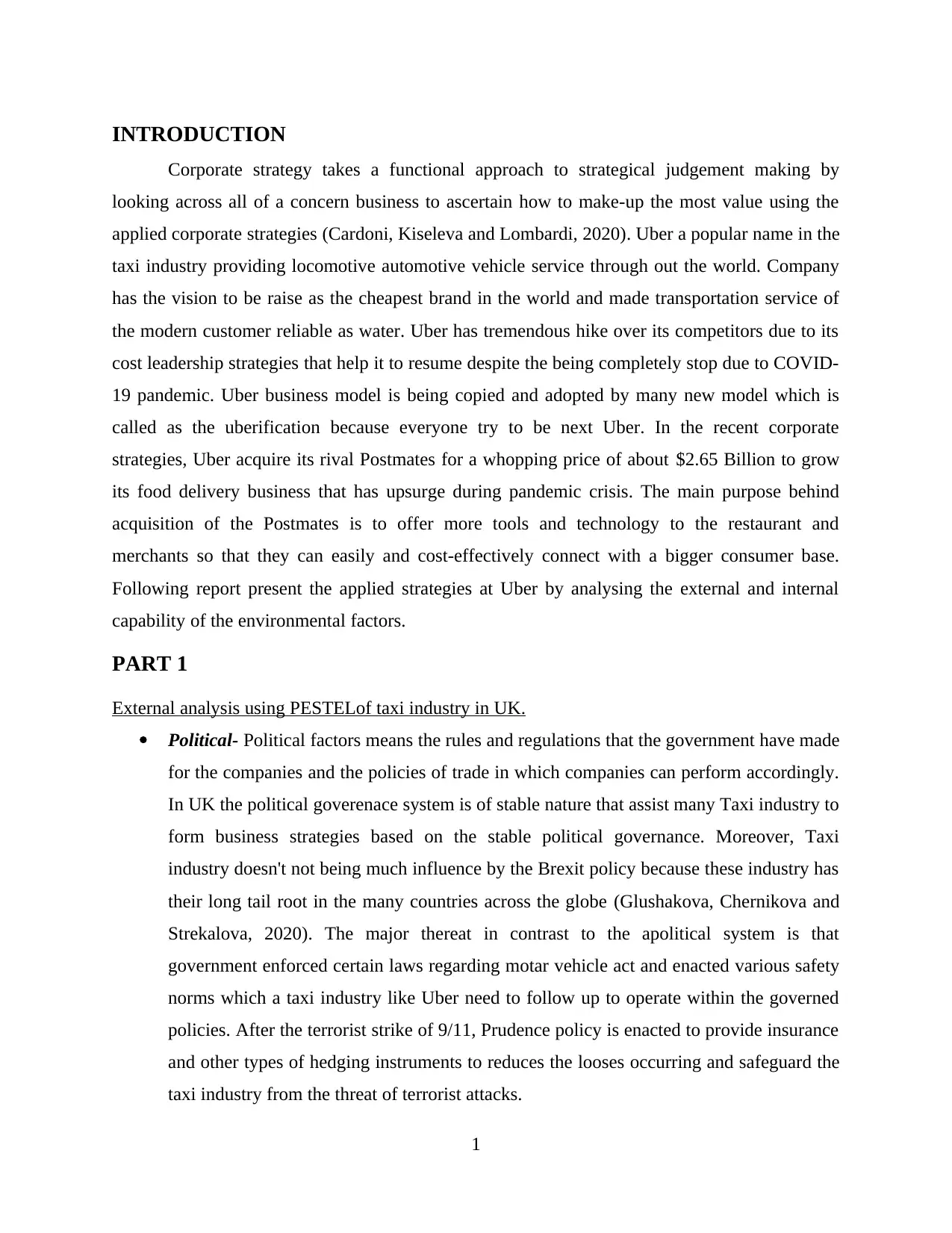
INTRODUCTION
Corporate strategy takes a functional approach to strategical judgement making by
looking across all of a concern business to ascertain how to make-up the most value using the
applied corporate strategies (Cardoni, Kiseleva and Lombardi, 2020). Uber a popular name in the
taxi industry providing locomotive automotive vehicle service through out the world. Company
has the vision to be raise as the cheapest brand in the world and made transportation service of
the modern customer reliable as water. Uber has tremendous hike over its competitors due to its
cost leadership strategies that help it to resume despite the being completely stop due to COVID-
19 pandemic. Uber business model is being copied and adopted by many new model which is
called as the uberification because everyone try to be next Uber. In the recent corporate
strategies, Uber acquire its rival Postmates for a whopping price of about $2.65 Billion to grow
its food delivery business that has upsurge during pandemic crisis. The main purpose behind
acquisition of the Postmates is to offer more tools and technology to the restaurant and
merchants so that they can easily and cost-effectively connect with a bigger consumer base.
Following report present the applied strategies at Uber by analysing the external and internal
capability of the environmental factors.
PART 1
External analysis using PESTELof taxi industry in UK.
Political- Political factors means the rules and regulations that the government have made
for the companies and the policies of trade in which companies can perform accordingly.
In UK the political goverenace system is of stable nature that assist many Taxi industry to
form business strategies based on the stable political governance. Moreover, Taxi
industry doesn't not being much influence by the Brexit policy because these industry has
their long tail root in the many countries across the globe (Glushakova, Chernikova and
Strekalova, 2020). The major thereat in contrast to the apolitical system is that
government enforced certain laws regarding motar vehicle act and enacted various safety
norms which a taxi industry like Uber need to follow up to operate within the governed
policies. After the terrorist strike of 9/11, Prudence policy is enacted to provide insurance
and other types of hedging instruments to reduces the looses occurring and safeguard the
taxi industry from the threat of terrorist attacks.
1
Corporate strategy takes a functional approach to strategical judgement making by
looking across all of a concern business to ascertain how to make-up the most value using the
applied corporate strategies (Cardoni, Kiseleva and Lombardi, 2020). Uber a popular name in the
taxi industry providing locomotive automotive vehicle service through out the world. Company
has the vision to be raise as the cheapest brand in the world and made transportation service of
the modern customer reliable as water. Uber has tremendous hike over its competitors due to its
cost leadership strategies that help it to resume despite the being completely stop due to COVID-
19 pandemic. Uber business model is being copied and adopted by many new model which is
called as the uberification because everyone try to be next Uber. In the recent corporate
strategies, Uber acquire its rival Postmates for a whopping price of about $2.65 Billion to grow
its food delivery business that has upsurge during pandemic crisis. The main purpose behind
acquisition of the Postmates is to offer more tools and technology to the restaurant and
merchants so that they can easily and cost-effectively connect with a bigger consumer base.
Following report present the applied strategies at Uber by analysing the external and internal
capability of the environmental factors.
PART 1
External analysis using PESTELof taxi industry in UK.
Political- Political factors means the rules and regulations that the government have made
for the companies and the policies of trade in which companies can perform accordingly.
In UK the political goverenace system is of stable nature that assist many Taxi industry to
form business strategies based on the stable political governance. Moreover, Taxi
industry doesn't not being much influence by the Brexit policy because these industry has
their long tail root in the many countries across the globe (Glushakova, Chernikova and
Strekalova, 2020). The major thereat in contrast to the apolitical system is that
government enforced certain laws regarding motar vehicle act and enacted various safety
norms which a taxi industry like Uber need to follow up to operate within the governed
policies. After the terrorist strike of 9/11, Prudence policy is enacted to provide insurance
and other types of hedging instruments to reduces the looses occurring and safeguard the
taxi industry from the threat of terrorist attacks.
1
⊘ This is a preview!⊘
Do you want full access?
Subscribe today to unlock all pages.

Trusted by 1+ million students worldwide
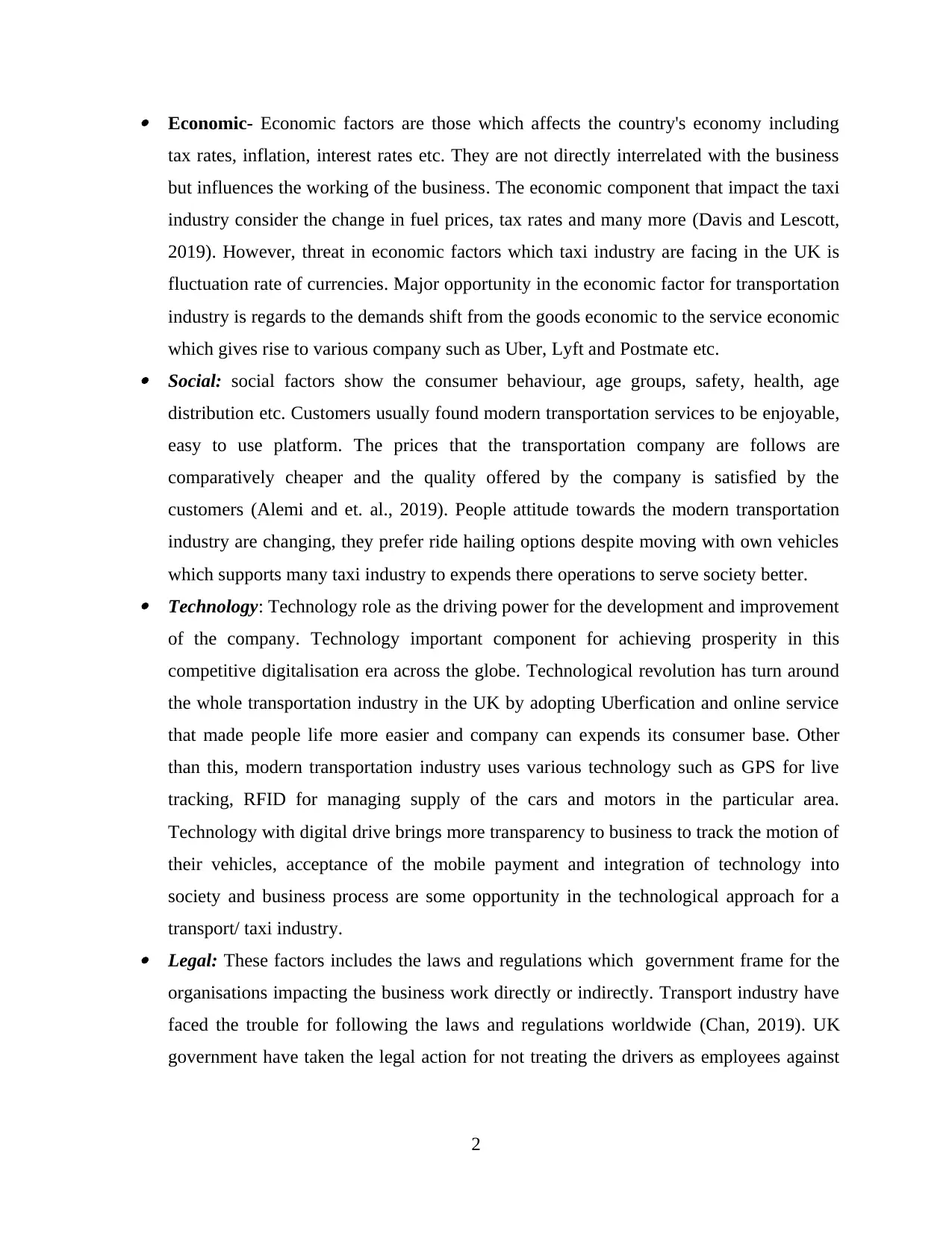
Economic- Economic factors are those which affects the country's economy including
tax rates, inflation, interest rates etc. They are not directly interrelated with the business
but influences the working of the business. The economic component that impact the taxi
industry consider the change in fuel prices, tax rates and many more (Davis and Lescott,
2019). However, threat in economic factors which taxi industry are facing in the UK is
fluctuation rate of currencies. Major opportunity in the economic factor for transportation
industry is regards to the demands shift from the goods economic to the service economic
which gives rise to various company such as Uber, Lyft and Postmate etc. Social: social factors show the consumer behaviour, age groups, safety, health, age
distribution etc. Customers usually found modern transportation services to be enjoyable,
easy to use platform. The prices that the transportation company are follows are
comparatively cheaper and the quality offered by the company is satisfied by the
customers (Alemi and et. al., 2019). People attitude towards the modern transportation
industry are changing, they prefer ride hailing options despite moving with own vehicles
which supports many taxi industry to expends there operations to serve society better. Technology: Technology role as the driving power for the development and improvement
of the company. Technology important component for achieving prosperity in this
competitive digitalisation era across the globe. Technological revolution has turn around
the whole transportation industry in the UK by adopting Uberfication and online service
that made people life more easier and company can expends its consumer base. Other
than this, modern transportation industry uses various technology such as GPS for live
tracking, RFID for managing supply of the cars and motors in the particular area.
Technology with digital drive brings more transparency to business to track the motion of
their vehicles, acceptance of the mobile payment and integration of technology into
society and business process are some opportunity in the technological approach for a
transport/ taxi industry. Legal: These factors includes the laws and regulations which government frame for the
organisations impacting the business work directly or indirectly. Transport industry have
faced the trouble for following the laws and regulations worldwide (Chan, 2019). UK
government have taken the legal action for not treating the drivers as employees against
2
tax rates, inflation, interest rates etc. They are not directly interrelated with the business
but influences the working of the business. The economic component that impact the taxi
industry consider the change in fuel prices, tax rates and many more (Davis and Lescott,
2019). However, threat in economic factors which taxi industry are facing in the UK is
fluctuation rate of currencies. Major opportunity in the economic factor for transportation
industry is regards to the demands shift from the goods economic to the service economic
which gives rise to various company such as Uber, Lyft and Postmate etc. Social: social factors show the consumer behaviour, age groups, safety, health, age
distribution etc. Customers usually found modern transportation services to be enjoyable,
easy to use platform. The prices that the transportation company are follows are
comparatively cheaper and the quality offered by the company is satisfied by the
customers (Alemi and et. al., 2019). People attitude towards the modern transportation
industry are changing, they prefer ride hailing options despite moving with own vehicles
which supports many taxi industry to expends there operations to serve society better. Technology: Technology role as the driving power for the development and improvement
of the company. Technology important component for achieving prosperity in this
competitive digitalisation era across the globe. Technological revolution has turn around
the whole transportation industry in the UK by adopting Uberfication and online service
that made people life more easier and company can expends its consumer base. Other
than this, modern transportation industry uses various technology such as GPS for live
tracking, RFID for managing supply of the cars and motors in the particular area.
Technology with digital drive brings more transparency to business to track the motion of
their vehicles, acceptance of the mobile payment and integration of technology into
society and business process are some opportunity in the technological approach for a
transport/ taxi industry. Legal: These factors includes the laws and regulations which government frame for the
organisations impacting the business work directly or indirectly. Transport industry have
faced the trouble for following the laws and regulations worldwide (Chan, 2019). UK
government have taken the legal action for not treating the drivers as employees against
2
Paraphrase This Document
Need a fresh take? Get an instant paraphrase of this document with our AI Paraphraser
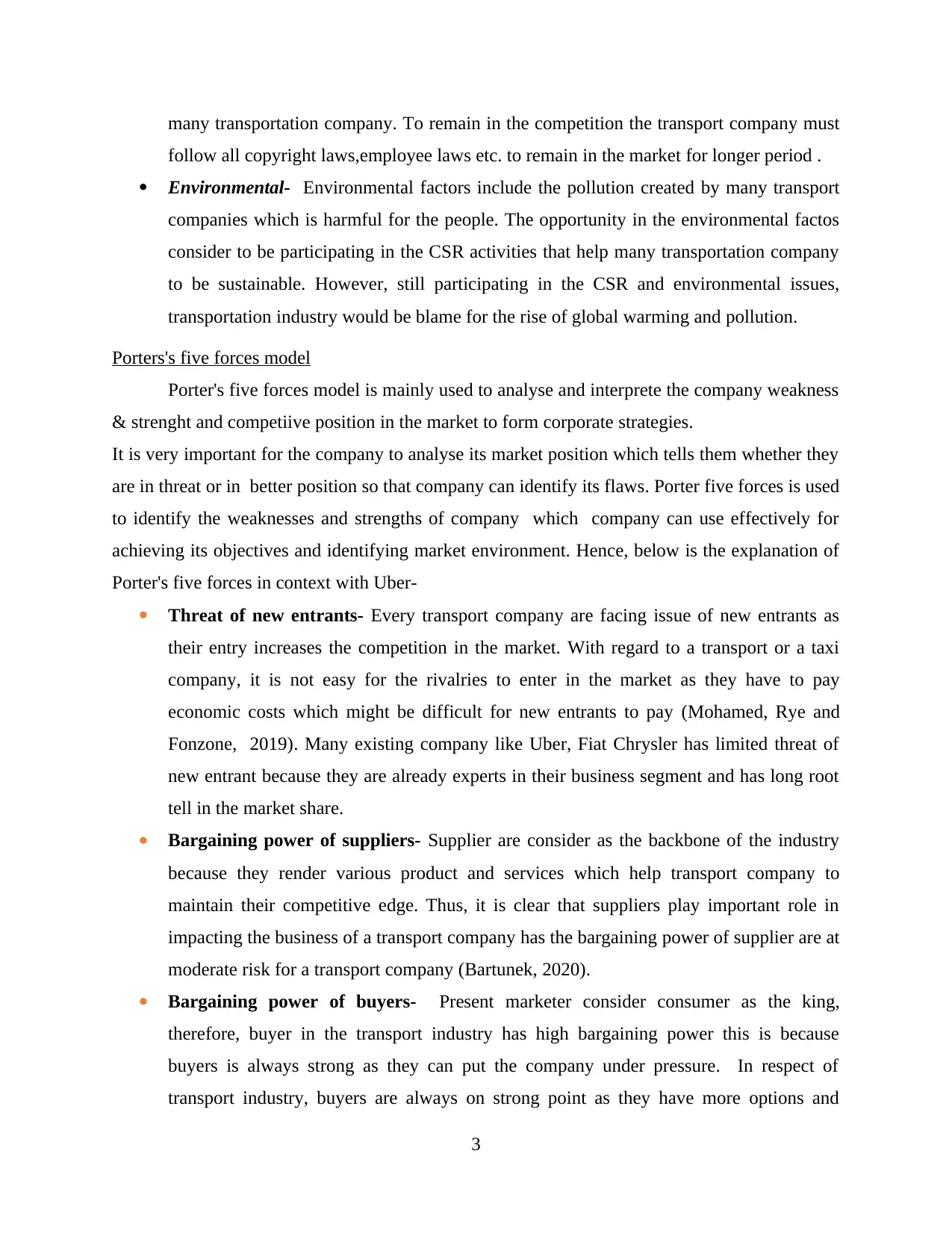
many transportation company. To remain in the competition the transport company must
follow all copyright laws,employee laws etc. to remain in the market for longer period .
Environmental- Environmental factors include the pollution created by many transport
companies which is harmful for the people. The opportunity in the environmental factos
consider to be participating in the CSR activities that help many transportation company
to be sustainable. However, still participating in the CSR and environmental issues,
transportation industry would be blame for the rise of global warming and pollution.
Porters's five forces model
Porter's five forces model is mainly used to analyse and interprete the company weakness
& strenght and competiive position in the market to form corporate strategies.
It is very important for the company to analyse its market position which tells them whether they
are in threat or in better position so that company can identify its flaws. Porter five forces is used
to identify the weaknesses and strengths of company which company can use effectively for
achieving its objectives and identifying market environment. Hence, below is the explanation of
Porter's five forces in context with Uber-
Threat of new entrants- Every transport company are facing issue of new entrants as
their entry increases the competition in the market. With regard to a transport or a taxi
company, it is not easy for the rivalries to enter in the market as they have to pay
economic costs which might be difficult for new entrants to pay (Mohamed, Rye and
Fonzone, 2019). Many existing company like Uber, Fiat Chrysler has limited threat of
new entrant because they are already experts in their business segment and has long root
tell in the market share.
Bargaining power of suppliers- Supplier are consider as the backbone of the industry
because they render various product and services which help transport company to
maintain their competitive edge. Thus, it is clear that suppliers play important role in
impacting the business of a transport company has the bargaining power of supplier are at
moderate risk for a transport company (Bartunek, 2020).
Bargaining power of buyers- Present marketer consider consumer as the king,
therefore, buyer in the transport industry has high bargaining power this is because
buyers is always strong as they can put the company under pressure. In respect of
transport industry, buyers are always on strong point as they have more options and
3
follow all copyright laws,employee laws etc. to remain in the market for longer period .
Environmental- Environmental factors include the pollution created by many transport
companies which is harmful for the people. The opportunity in the environmental factos
consider to be participating in the CSR activities that help many transportation company
to be sustainable. However, still participating in the CSR and environmental issues,
transportation industry would be blame for the rise of global warming and pollution.
Porters's five forces model
Porter's five forces model is mainly used to analyse and interprete the company weakness
& strenght and competiive position in the market to form corporate strategies.
It is very important for the company to analyse its market position which tells them whether they
are in threat or in better position so that company can identify its flaws. Porter five forces is used
to identify the weaknesses and strengths of company which company can use effectively for
achieving its objectives and identifying market environment. Hence, below is the explanation of
Porter's five forces in context with Uber-
Threat of new entrants- Every transport company are facing issue of new entrants as
their entry increases the competition in the market. With regard to a transport or a taxi
company, it is not easy for the rivalries to enter in the market as they have to pay
economic costs which might be difficult for new entrants to pay (Mohamed, Rye and
Fonzone, 2019). Many existing company like Uber, Fiat Chrysler has limited threat of
new entrant because they are already experts in their business segment and has long root
tell in the market share.
Bargaining power of suppliers- Supplier are consider as the backbone of the industry
because they render various product and services which help transport company to
maintain their competitive edge. Thus, it is clear that suppliers play important role in
impacting the business of a transport company has the bargaining power of supplier are at
moderate risk for a transport company (Bartunek, 2020).
Bargaining power of buyers- Present marketer consider consumer as the king,
therefore, buyer in the transport industry has high bargaining power this is because
buyers is always strong as they can put the company under pressure. In respect of
transport industry, buyers are always on strong point as they have more options and
3
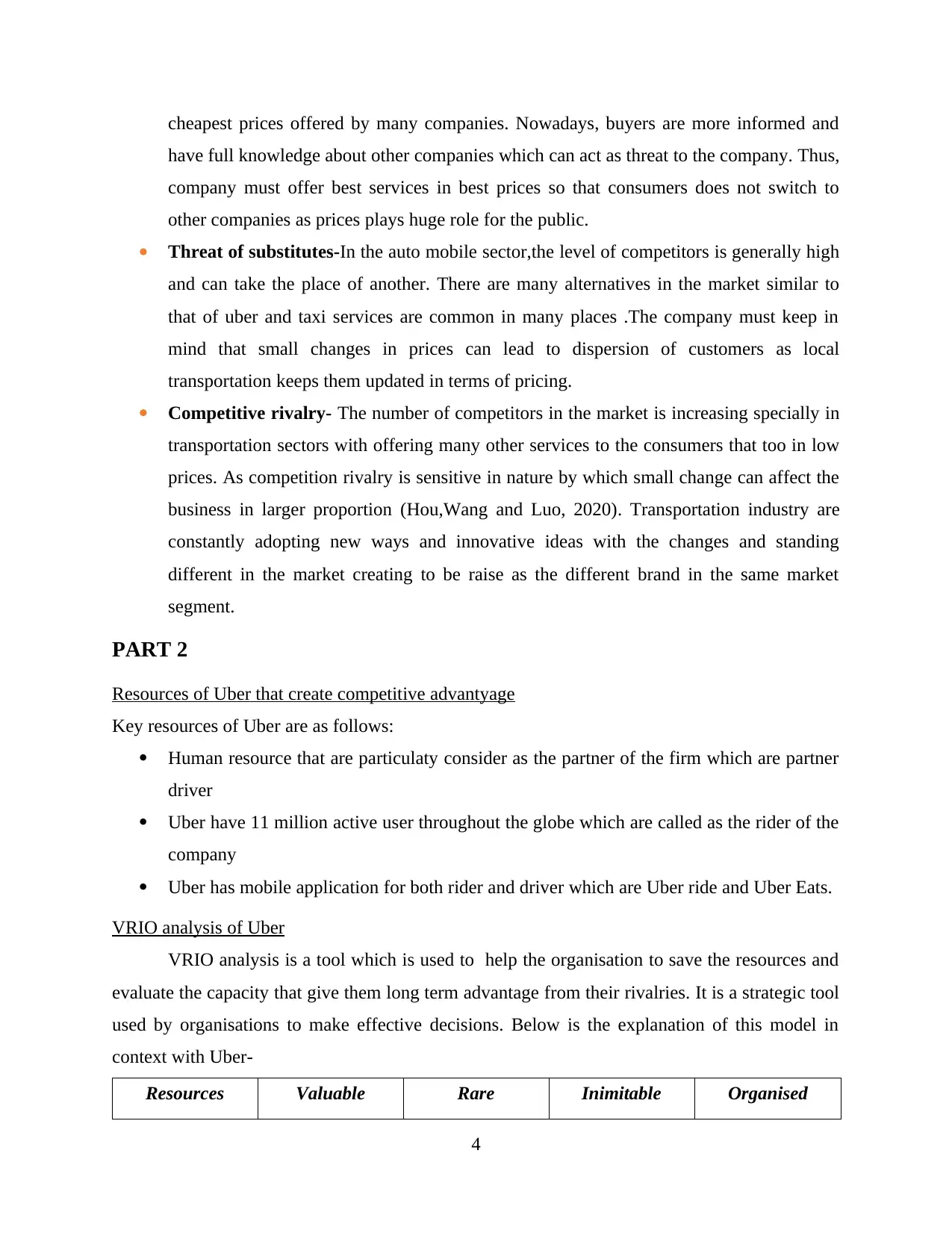
cheapest prices offered by many companies. Nowadays, buyers are more informed and
have full knowledge about other companies which can act as threat to the company. Thus,
company must offer best services in best prices so that consumers does not switch to
other companies as prices plays huge role for the public.
Threat of substitutes-In the auto mobile sector,the level of competitors is generally high
and can take the place of another. There are many alternatives in the market similar to
that of uber and taxi services are common in many places .The company must keep in
mind that small changes in prices can lead to dispersion of customers as local
transportation keeps them updated in terms of pricing.
Competitive rivalry- The number of competitors in the market is increasing specially in
transportation sectors with offering many other services to the consumers that too in low
prices. As competition rivalry is sensitive in nature by which small change can affect the
business in larger proportion (Hou,Wang and Luo, 2020). Transportation industry are
constantly adopting new ways and innovative ideas with the changes and standing
different in the market creating to be raise as the different brand in the same market
segment.
PART 2
Resources of Uber that create competitive advantyage
Key resources of Uber are as follows:
Human resource that are particulaty consider as the partner of the firm which are partner
driver
Uber have 11 million active user throughout the globe which are called as the rider of the
company
Uber has mobile application for both rider and driver which are Uber ride and Uber Eats.
VRIO analysis of Uber
VRIO analysis is a tool which is used to help the organisation to save the resources and
evaluate the capacity that give them long term advantage from their rivalries. It is a strategic tool
used by organisations to make effective decisions. Below is the explanation of this model in
context with Uber-
Resources Valuable Rare Inimitable Organised
4
have full knowledge about other companies which can act as threat to the company. Thus,
company must offer best services in best prices so that consumers does not switch to
other companies as prices plays huge role for the public.
Threat of substitutes-In the auto mobile sector,the level of competitors is generally high
and can take the place of another. There are many alternatives in the market similar to
that of uber and taxi services are common in many places .The company must keep in
mind that small changes in prices can lead to dispersion of customers as local
transportation keeps them updated in terms of pricing.
Competitive rivalry- The number of competitors in the market is increasing specially in
transportation sectors with offering many other services to the consumers that too in low
prices. As competition rivalry is sensitive in nature by which small change can affect the
business in larger proportion (Hou,Wang and Luo, 2020). Transportation industry are
constantly adopting new ways and innovative ideas with the changes and standing
different in the market creating to be raise as the different brand in the same market
segment.
PART 2
Resources of Uber that create competitive advantyage
Key resources of Uber are as follows:
Human resource that are particulaty consider as the partner of the firm which are partner
driver
Uber have 11 million active user throughout the globe which are called as the rider of the
company
Uber has mobile application for both rider and driver which are Uber ride and Uber Eats.
VRIO analysis of Uber
VRIO analysis is a tool which is used to help the organisation to save the resources and
evaluate the capacity that give them long term advantage from their rivalries. It is a strategic tool
used by organisations to make effective decisions. Below is the explanation of this model in
context with Uber-
Resources Valuable Rare Inimitable Organised
4
⊘ This is a preview!⊘
Do you want full access?
Subscribe today to unlock all pages.

Trusted by 1+ million students worldwide

Brand reputation Yes No No No
Distribution
Channel
Yes Yes No No
Organisation
Structure
Yes Yes Yes No
Manpower Yes Yes Yes Yes
Valuable: Brand reputation of uber is excellent as the company have created its image
globally because of its services and customer satisfaction. On the other side ,uber app is
sufficient to outreach millions of people as the application itself provides all the services
to consumers making the application valuable (McCarthy and et. al., 2019). The
organisation structure of uber is almost simple as they adopt straightforward model
working on licenses, permits,services etc. The manpower of uber are effective in terms of
their working as they are punctual in their timings, polite with their customers and follow
all rules and regulations which are provided to them in their training sessions thus,
creating value for the company.
Rare: The application of uber is fast and easy as it provides E-hail services for hiring a
driver from almost any location and the option of surge pricing changes cost of services
timely. Company follows different organisation structure which proves to be flexible for
the workers (Soares and et. al., 2019). Uber does not have any any cab yet it provides 1
million cabs through its partner network which is rare then other industry working. The
workforce that are employed in the company are dedicated and trained in their work
giving effective and profitable results to the company, making themselves unique.
Inimitable: The organisation structure of the company is different compared to that of
others as the working procedures which the company follows is quite different making it
difficult for others to imitate. The quality of work that workers perform is unique and
distinctive and the dedication that workers perform in their work is difficult for others to
imitate.
5
Distribution
Channel
Yes Yes No No
Organisation
Structure
Yes Yes Yes No
Manpower Yes Yes Yes Yes
Valuable: Brand reputation of uber is excellent as the company have created its image
globally because of its services and customer satisfaction. On the other side ,uber app is
sufficient to outreach millions of people as the application itself provides all the services
to consumers making the application valuable (McCarthy and et. al., 2019). The
organisation structure of uber is almost simple as they adopt straightforward model
working on licenses, permits,services etc. The manpower of uber are effective in terms of
their working as they are punctual in their timings, polite with their customers and follow
all rules and regulations which are provided to them in their training sessions thus,
creating value for the company.
Rare: The application of uber is fast and easy as it provides E-hail services for hiring a
driver from almost any location and the option of surge pricing changes cost of services
timely. Company follows different organisation structure which proves to be flexible for
the workers (Soares and et. al., 2019). Uber does not have any any cab yet it provides 1
million cabs through its partner network which is rare then other industry working. The
workforce that are employed in the company are dedicated and trained in their work
giving effective and profitable results to the company, making themselves unique.
Inimitable: The organisation structure of the company is different compared to that of
others as the working procedures which the company follows is quite different making it
difficult for others to imitate. The quality of work that workers perform is unique and
distinctive and the dedication that workers perform in their work is difficult for others to
imitate.
5
Paraphrase This Document
Need a fresh take? Get an instant paraphrase of this document with our AI Paraphraser

Organised: The manpower of Uber is trained ,effective, and contributes fully for the
company but the company must provide better reimbursements facilities so that workers
stay organised and motivated with the company (Brunow,Pestel and Partridge,2019).
Porter’s Value Chain Analysis
This framework is useful in order to identify that how an organisation tends to create value
for their potential customers. It is useful in order to develop competitive advantage for an
organisation which is useful for the success and growth of an organisation. This analysis is
prominently discussed as underneath:
Primary activities: These activities are suitably linked with the physical creation, maintenance,
support of commodities and sale. Hence, these activities undertake: Inbound logistics: In terms of Uber, the suppliers are the major key factor for the specific
logistics. As it leads to undertake suitable process which is being concerned with the
distribution and storing of the products and services at the internal level. Operations: In context of Uber, company tends to take suitable benefits for the
operational system in order to create value for their customers. It undertakes the suitable
process that leads to transform the input of commodities into the outputs in an effective
manner (Hernández, Lemus and Medrano, 2020). Outbound logistics: These activities undertake the prominent process for the delivering
of commodity to their potential customers. In context of Uber, company tends to take
benefits of their effective distribution network considering the both internal and external
factor within an organisation. Marketing and sales: It undertake the suitable strategies which is useful regarding the
marketing and sales of suitable product (Liu, Yang, 2019). In terms of Uber which is a
transportation company has the advantage of after sales services that leads to create
competitive edge in front of their competitors and give tough competition. Service: It undertake the prominent activities which is being related with the suitable
maintenance of the value for their potential customer through the factors of innovation
and development of products (Smales,2019). In terms of Uber which is a transportation
company is quite famous for offering the effective and excellent services to their
potential customers in order to have effective growth and success.
6
company but the company must provide better reimbursements facilities so that workers
stay organised and motivated with the company (Brunow,Pestel and Partridge,2019).
Porter’s Value Chain Analysis
This framework is useful in order to identify that how an organisation tends to create value
for their potential customers. It is useful in order to develop competitive advantage for an
organisation which is useful for the success and growth of an organisation. This analysis is
prominently discussed as underneath:
Primary activities: These activities are suitably linked with the physical creation, maintenance,
support of commodities and sale. Hence, these activities undertake: Inbound logistics: In terms of Uber, the suppliers are the major key factor for the specific
logistics. As it leads to undertake suitable process which is being concerned with the
distribution and storing of the products and services at the internal level. Operations: In context of Uber, company tends to take suitable benefits for the
operational system in order to create value for their customers. It undertakes the suitable
process that leads to transform the input of commodities into the outputs in an effective
manner (Hernández, Lemus and Medrano, 2020). Outbound logistics: These activities undertake the prominent process for the delivering
of commodity to their potential customers. In context of Uber, company tends to take
benefits of their effective distribution network considering the both internal and external
factor within an organisation. Marketing and sales: It undertake the suitable strategies which is useful regarding the
marketing and sales of suitable product (Liu, Yang, 2019). In terms of Uber which is a
transportation company has the advantage of after sales services that leads to create
competitive edge in front of their competitors and give tough competition. Service: It undertake the prominent activities which is being related with the suitable
maintenance of the value for their potential customer through the factors of innovation
and development of products (Smales,2019). In terms of Uber which is a transportation
company is quite famous for offering the effective and excellent services to their
potential customers in order to have effective growth and success.
6
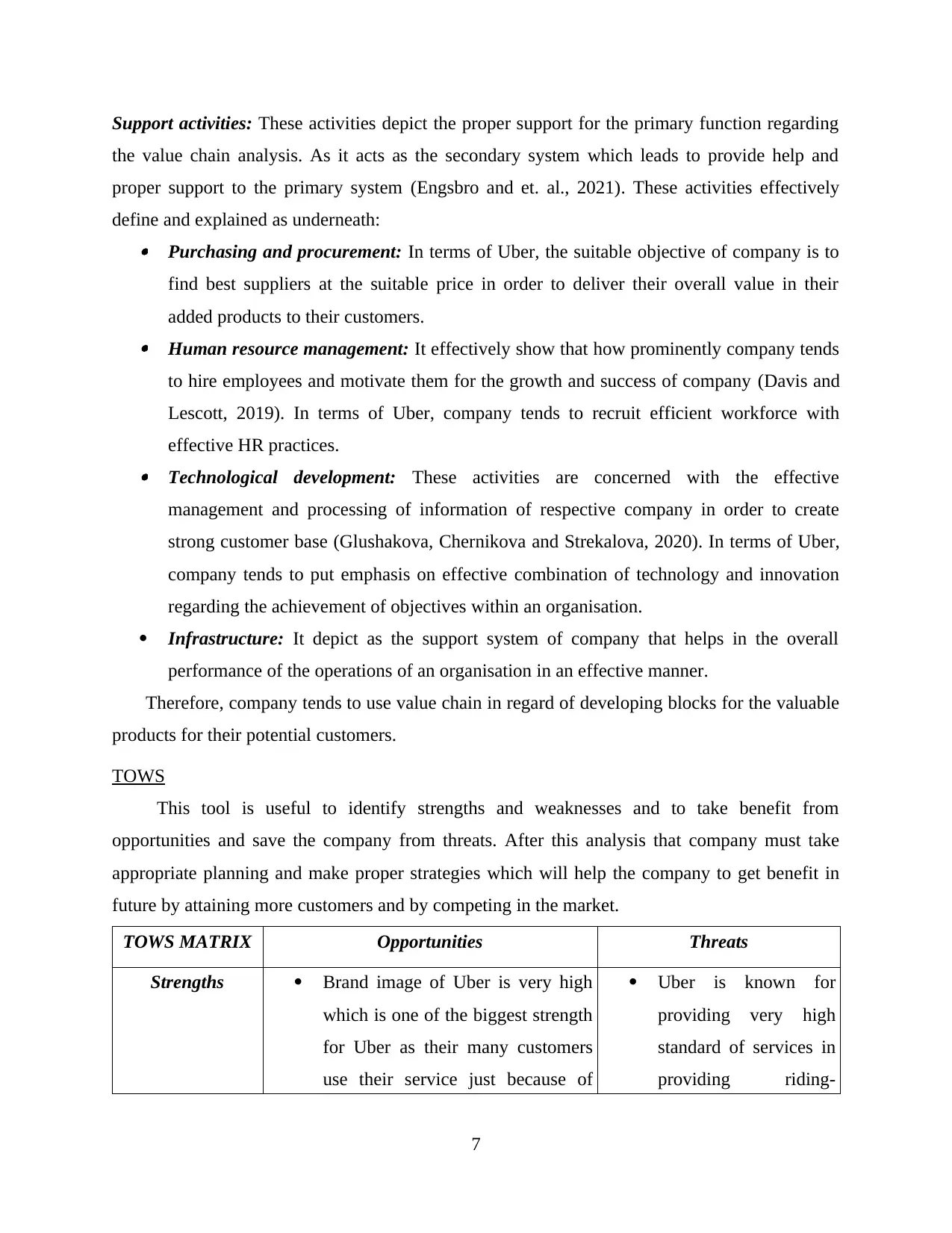
Support activities: These activities depict the proper support for the primary function regarding
the value chain analysis. As it acts as the secondary system which leads to provide help and
proper support to the primary system (Engsbro and et. al., 2021). These activities effectively
define and explained as underneath: Purchasing and procurement: In terms of Uber, the suitable objective of company is to
find best suppliers at the suitable price in order to deliver their overall value in their
added products to their customers. Human resource management: It effectively show that how prominently company tends
to hire employees and motivate them for the growth and success of company (Davis and
Lescott, 2019). In terms of Uber, company tends to recruit efficient workforce with
effective HR practices. Technological development: These activities are concerned with the effective
management and processing of information of respective company in order to create
strong customer base (Glushakova, Chernikova and Strekalova, 2020). In terms of Uber,
company tends to put emphasis on effective combination of technology and innovation
regarding the achievement of objectives within an organisation.
Infrastructure: It depict as the support system of company that helps in the overall
performance of the operations of an organisation in an effective manner.
Therefore, company tends to use value chain in regard of developing blocks for the valuable
products for their potential customers.
TOWS
This tool is useful to identify strengths and weaknesses and to take benefit from
opportunities and save the company from threats. After this analysis that company must take
appropriate planning and make proper strategies which will help the company to get benefit in
future by attaining more customers and by competing in the market.
TOWS MATRIX Opportunities Threats
Strengths Brand image of Uber is very high
which is one of the biggest strength
for Uber as their many customers
use their service just because of
Uber is known for
providing very high
standard of services in
providing riding-
7
the value chain analysis. As it acts as the secondary system which leads to provide help and
proper support to the primary system (Engsbro and et. al., 2021). These activities effectively
define and explained as underneath: Purchasing and procurement: In terms of Uber, the suitable objective of company is to
find best suppliers at the suitable price in order to deliver their overall value in their
added products to their customers. Human resource management: It effectively show that how prominently company tends
to hire employees and motivate them for the growth and success of company (Davis and
Lescott, 2019). In terms of Uber, company tends to recruit efficient workforce with
effective HR practices. Technological development: These activities are concerned with the effective
management and processing of information of respective company in order to create
strong customer base (Glushakova, Chernikova and Strekalova, 2020). In terms of Uber,
company tends to put emphasis on effective combination of technology and innovation
regarding the achievement of objectives within an organisation.
Infrastructure: It depict as the support system of company that helps in the overall
performance of the operations of an organisation in an effective manner.
Therefore, company tends to use value chain in regard of developing blocks for the valuable
products for their potential customers.
TOWS
This tool is useful to identify strengths and weaknesses and to take benefit from
opportunities and save the company from threats. After this analysis that company must take
appropriate planning and make proper strategies which will help the company to get benefit in
future by attaining more customers and by competing in the market.
TOWS MATRIX Opportunities Threats
Strengths Brand image of Uber is very high
which is one of the biggest strength
for Uber as their many customers
use their service just because of
Uber is known for
providing very high
standard of services in
providing riding-
7
⊘ This is a preview!⊘
Do you want full access?
Subscribe today to unlock all pages.

Trusted by 1+ million students worldwide
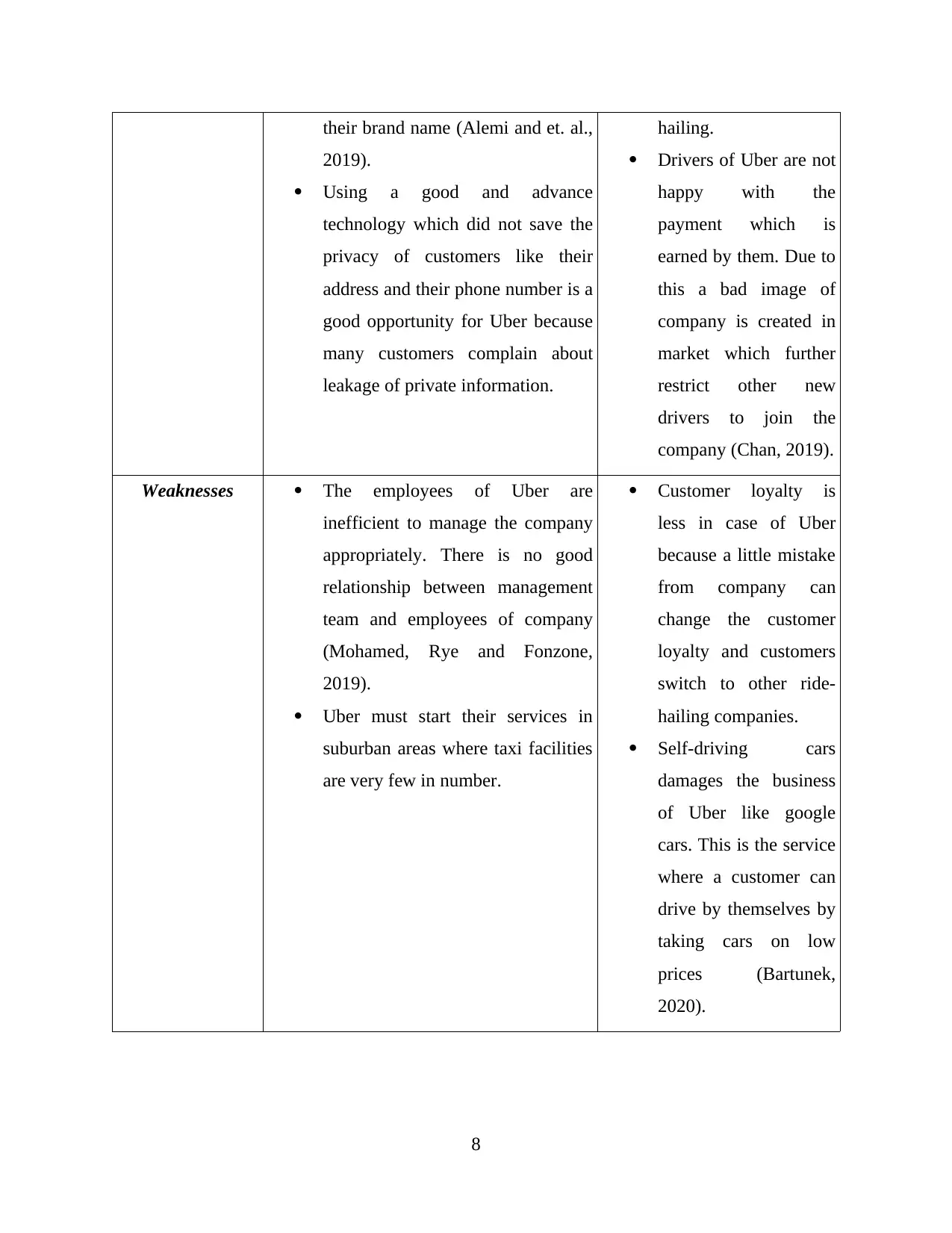
their brand name (Alemi and et. al.,
2019).
Using a good and advance
technology which did not save the
privacy of customers like their
address and their phone number is a
good opportunity for Uber because
many customers complain about
leakage of private information.
hailing.
Drivers of Uber are not
happy with the
payment which is
earned by them. Due to
this a bad image of
company is created in
market which further
restrict other new
drivers to join the
company (Chan, 2019).
Weaknesses The employees of Uber are
inefficient to manage the company
appropriately. There is no good
relationship between management
team and employees of company
(Mohamed, Rye and Fonzone,
2019).
Uber must start their services in
suburban areas where taxi facilities
are very few in number.
Customer loyalty is
less in case of Uber
because a little mistake
from company can
change the customer
loyalty and customers
switch to other ride-
hailing companies.
Self-driving cars
damages the business
of Uber like google
cars. This is the service
where a customer can
drive by themselves by
taking cars on low
prices (Bartunek,
2020).
8
2019).
Using a good and advance
technology which did not save the
privacy of customers like their
address and their phone number is a
good opportunity for Uber because
many customers complain about
leakage of private information.
hailing.
Drivers of Uber are not
happy with the
payment which is
earned by them. Due to
this a bad image of
company is created in
market which further
restrict other new
drivers to join the
company (Chan, 2019).
Weaknesses The employees of Uber are
inefficient to manage the company
appropriately. There is no good
relationship between management
team and employees of company
(Mohamed, Rye and Fonzone,
2019).
Uber must start their services in
suburban areas where taxi facilities
are very few in number.
Customer loyalty is
less in case of Uber
because a little mistake
from company can
change the customer
loyalty and customers
switch to other ride-
hailing companies.
Self-driving cars
damages the business
of Uber like google
cars. This is the service
where a customer can
drive by themselves by
taking cars on low
prices (Bartunek,
2020).
8
Paraphrase This Document
Need a fresh take? Get an instant paraphrase of this document with our AI Paraphraser

PART 3
SAFe Criteria
The SAFe technique is used to evaluate the best opportunities available for the company
in a upcoming time period. The framework determines an ability to create, maintain and develop
a centralized strategy for the company to remain competitive in a market environment. The
framework helps Uber in determining and analysing future possible threats and provide a ways to
protect the company with these threats. The SAFe model is described below :
Suitability : The prime purpose of any strategic analysis is to have better understanding
of a market in which the business is operation and an organisation itself. Suitability is a
term used to define whether a suggested or proposed strategy will help the Uber in
maintaining its competitive position in a market (Hou,Wang and Luo, 2020). Uber list out
the various opportunities in which it can excel and find out the future threats which can
drag the company off from its current position. Apart from this Uber finds out the areas
of its strengths and weaknesses by analysing its internal environment. An effective and
desired strategy can be formulated, by considering all the factors that influence the
performance of a Uber, to enhance the productivity of a company.
Acceptability : After analysing and determining the suitable strategy for a company, the
next step is to check whether the proposed strategy delivers a desired result or meets the
expectation of people and stakeholders. The products and services delivered by the
9
SAFe Criteria
The SAFe technique is used to evaluate the best opportunities available for the company
in a upcoming time period. The framework determines an ability to create, maintain and develop
a centralized strategy for the company to remain competitive in a market environment. The
framework helps Uber in determining and analysing future possible threats and provide a ways to
protect the company with these threats. The SAFe model is described below :
Suitability : The prime purpose of any strategic analysis is to have better understanding
of a market in which the business is operation and an organisation itself. Suitability is a
term used to define whether a suggested or proposed strategy will help the Uber in
maintaining its competitive position in a market (Hou,Wang and Luo, 2020). Uber list out
the various opportunities in which it can excel and find out the future threats which can
drag the company off from its current position. Apart from this Uber finds out the areas
of its strengths and weaknesses by analysing its internal environment. An effective and
desired strategy can be formulated, by considering all the factors that influence the
performance of a Uber, to enhance the productivity of a company.
Acceptability : After analysing and determining the suitable strategy for a company, the
next step is to check whether the proposed strategy delivers a desired result or meets the
expectation of people and stakeholders. The products and services delivered by the
9
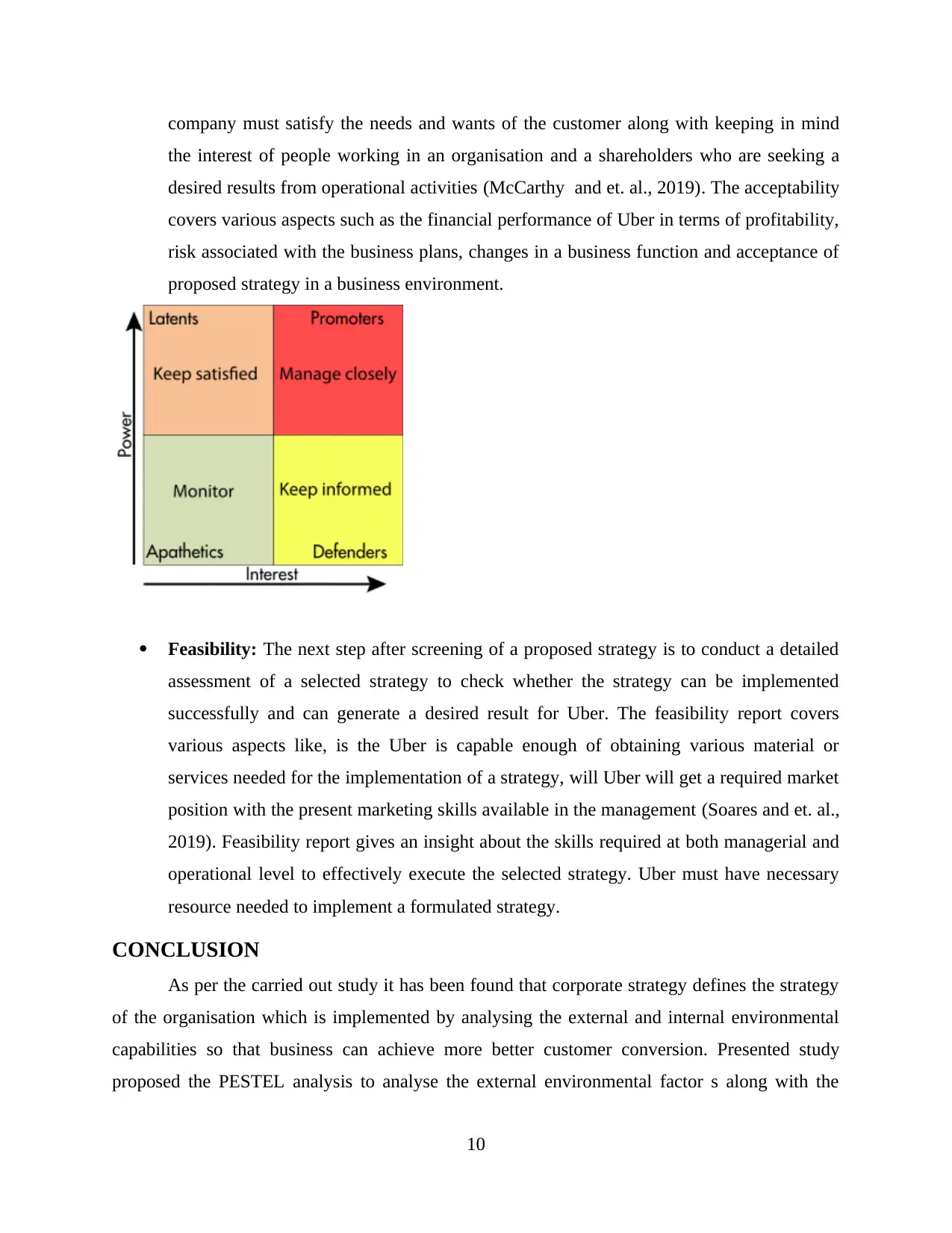
company must satisfy the needs and wants of the customer along with keeping in mind
the interest of people working in an organisation and a shareholders who are seeking a
desired results from operational activities (McCarthy and et. al., 2019). The acceptability
covers various aspects such as the financial performance of Uber in terms of profitability,
risk associated with the business plans, changes in a business function and acceptance of
proposed strategy in a business environment.
Feasibility: The next step after screening of a proposed strategy is to conduct a detailed
assessment of a selected strategy to check whether the strategy can be implemented
successfully and can generate a desired result for Uber. The feasibility report covers
various aspects like, is the Uber is capable enough of obtaining various material or
services needed for the implementation of a strategy, will Uber will get a required market
position with the present marketing skills available in the management (Soares and et. al.,
2019). Feasibility report gives an insight about the skills required at both managerial and
operational level to effectively execute the selected strategy. Uber must have necessary
resource needed to implement a formulated strategy.
CONCLUSION
As per the carried out study it has been found that corporate strategy defines the strategy
of the organisation which is implemented by analysing the external and internal environmental
capabilities so that business can achieve more better customer conversion. Presented study
proposed the PESTEL analysis to analyse the external environmental factor s along with the
10
the interest of people working in an organisation and a shareholders who are seeking a
desired results from operational activities (McCarthy and et. al., 2019). The acceptability
covers various aspects such as the financial performance of Uber in terms of profitability,
risk associated with the business plans, changes in a business function and acceptance of
proposed strategy in a business environment.
Feasibility: The next step after screening of a proposed strategy is to conduct a detailed
assessment of a selected strategy to check whether the strategy can be implemented
successfully and can generate a desired result for Uber. The feasibility report covers
various aspects like, is the Uber is capable enough of obtaining various material or
services needed for the implementation of a strategy, will Uber will get a required market
position with the present marketing skills available in the management (Soares and et. al.,
2019). Feasibility report gives an insight about the skills required at both managerial and
operational level to effectively execute the selected strategy. Uber must have necessary
resource needed to implement a formulated strategy.
CONCLUSION
As per the carried out study it has been found that corporate strategy defines the strategy
of the organisation which is implemented by analysing the external and internal environmental
capabilities so that business can achieve more better customer conversion. Presented study
proposed the PESTEL analysis to analyse the external environmental factor s along with the
10
⊘ This is a preview!⊘
Do you want full access?
Subscribe today to unlock all pages.

Trusted by 1+ million students worldwide
1 out of 14
Related Documents
Your All-in-One AI-Powered Toolkit for Academic Success.
+13062052269
info@desklib.com
Available 24*7 on WhatsApp / Email
![[object Object]](/_next/static/media/star-bottom.7253800d.svg)
Unlock your academic potential
Copyright © 2020–2025 A2Z Services. All Rights Reserved. Developed and managed by ZUCOL.





